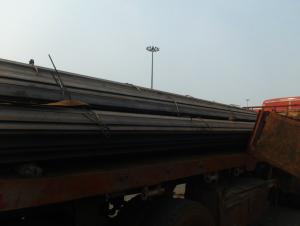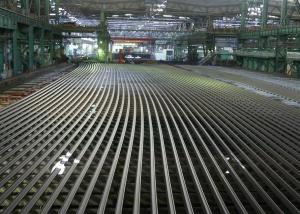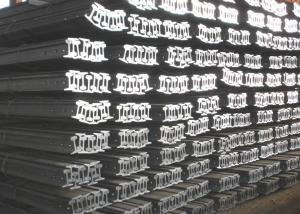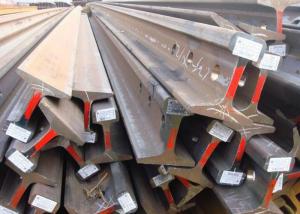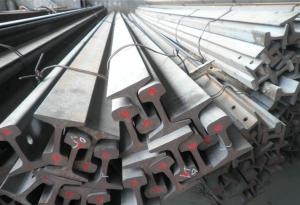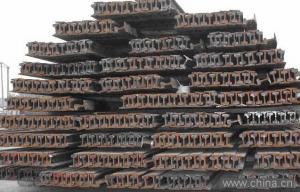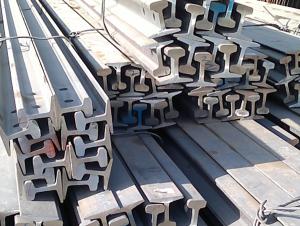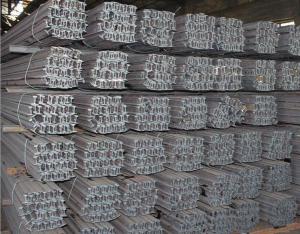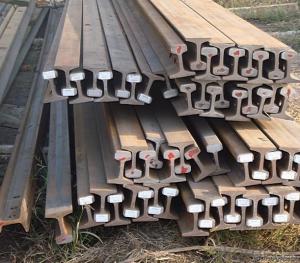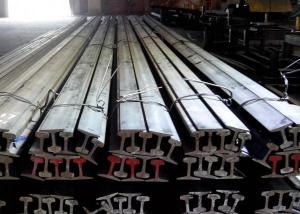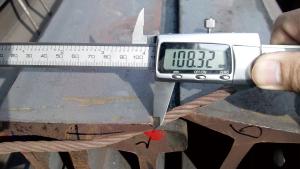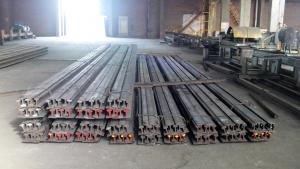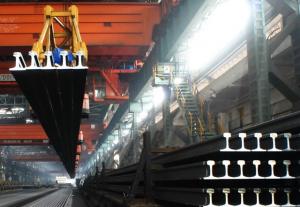Steel Light Rail GB 11264-89, DIN, AREMA, JIS, BS, UIC
- Loading Port:
- China main port
- Payment Terms:
- TT or LC
- Min Order Qty:
- 25 m.t.
- Supply Capability:
- 100000 m.t./month
OKorder Service Pledge
OKorder Financial Service
You Might Also Like
Product Description of Steel Light Rail GB 11264-89, DIN, AREMA, JIS, BS, UIC:
Alloy No | Grade | Element(%) | ||||
C
| Mn | S
| P
| Si
| ||
Q235 |
B
|
0.12—0.20 |
0.3—0.7 |
≤0.045 |
≤0.045
|
≤0.3
|
Invoicing on theoretical weight or actual weight as customer request
Payment terms: 30% advance payment by T/T, 70% payment against the copy of the B/L; 100% L/C at sight, etc.
Usages of Steel Light Rail GB 11264-89, DIN, AREMA, JIS, BS, UIC:
Light rail is mainly used in forest region, mines, factories and construction sites laid of the place such as temporary transport line and light motorcycles with line. Be widely used for railway, subway, transportation track, express, curve way, tunnel way and so on.
Packaging & Delivery of Steel Light Rail GB 11264-89, DIN, AREMA, JIS, BS, UIC:
1. Packing: it is nude packed in bundles by steel wire rod
2. Bundle weight: not more than 3.5MT for bulk vessel; less than 3 MT for container load
3. Marks:
Color marking: There will be color marking on both end of the bundle for the cargo delivered by bulk vessel. That makes it easily to distinguish at the destination port.
Tag mark: there will be tag mark tied up on the bundles. The information usually including supplier logo and name, product name, made in China, shipping marks and other information request by the customer.
If loading by container the marking is not needed, but we will prepare it as customer request.
4. Transportation: the goods are delivered by truck from mill to loading port, the maximum quantity can be loaded is around 40MTs by each truck. If the order quantity cannot reach the full truck loaded, the transportation cost per ton will be little higher than full load.
5. Delivered by container or bulk vessel
6. Delivery Time: All the Hot Rolled Steel Rail will be transpoted at the port of Tianjin, China within 30 days after receiving the advance payment by T/T or the orginal L/C at sight.
Inspection of Steel Light Rail GB 11264-89, DIN, AREMA, JIS, BS, UIC:
We will send the MTC of the factory to the clients dirrectly which contain the anlisis of the heat, chemiqul composition, phisical characteristicas, etc.
And our inspectors will arrive at the factory to meke the inspection of the size, length, weight and quantity before the transportation from the factory.
FAQ:
Q1: Why buy Materials & Equipment from OKorder.com?
A1: All products offered byOKorder.com are carefully selected from China's most reliable manufacturing enterprises. Through its ISO certifications, OKorder.com adheres to the highest standards and a commitment to supply chain safety and customer satisfaction.
Q2: How do we guarantee the quality of our products?
A2: We have established an advanced quality management system which conducts strict quality tests at every step, from raw materials to the final product. At the same time, we provide extensive follow-up service assurances as required.
Q3: How soon can we receive the product after purchase?
A3: Within three days of placing an order, we will begin production. The specific shipping date is dependent upon international and government factors, but is typically 7 to 10 workdays
Images:
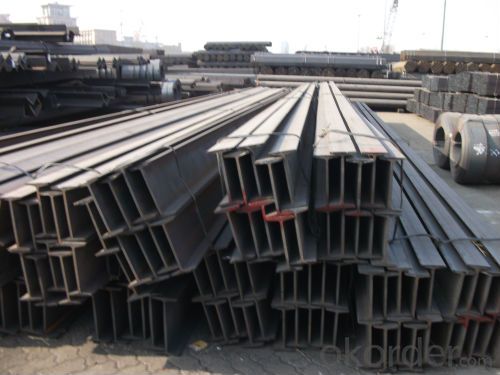

- Q: How are steel rails protected against chemical exposure?
- Steel rails are protected against chemical exposure through various methods such as applying protective coatings, galvanizing, and regular maintenance. These measures help prevent corrosion and degradation caused by chemical contact, ensuring the longevity and reliability of the rails.
- Q: How are steel rails made?
- Steel rails are made through a process called rail manufacturing, which involves several steps. First, iron ore is mined and converted into iron through a process called smelting. The iron is then refined and mixed with carbon and other alloying elements to form steel. The steel is heated and rolled into long, flat bars known as blooms. These blooms are reheated and passed through a series of rollers to gradually shape them into the desired rail profile. Finally, the rails are cut to the required length, heat-treated for strength, and undergo various quality control tests before being ready for use in railways.
- Q: Can steel rails be used for port railways?
- Yes, steel rails can be used for port railways. Steel rails are commonly used in railway tracks due to their strength, durability, and ability to handle heavy loads. These qualities make them suitable for port railways as well, where there is a need to transport large quantities of goods and materials efficiently.
- Q: Why is the thermit reaction welded to rails instead of welded rails?
- Steel contains other added elements, while the thermit reaction produces only iron.
- Q: How are steel rails graded for strength?
- Steel rails are graded for strength using a standardized system known as the United States Steel Rail (USSR) grading system. This system categorizes steel rails based on their minimum tensile strength, which is the maximum amount of stress the rail can withstand without breaking. The USSR grading system has five main classes: A, B, C, D, and E. Each class represents a specific range of minimum tensile strength. Class A has the lowest tensile strength, while Class E has the highest. The minimum tensile strength for each class is as follows: Class A - 60,000 psi, Class B - 70,000 psi, Class C - 80,000 psi, Class D - 90,000 psi, and Class E - 100,000 psi. To determine the grade of a steel rail, various tests are conducted, including tensile testing. In this test, a sample of the rail material is subjected to increasing amounts of tension until it breaks. The amount of force required to cause the rail to break is measured, and this determines its tensile strength. In addition to tensile strength, other factors such as hardness, ductility, and resistance to wear are also considered when grading steel rails. These factors are crucial in ensuring that the rail can withstand the heavy loads, constant stress, and wear and tear experienced in railway operations. By using the USSR grading system, rail manufacturers and engineers can accurately assess the strength and durability of steel rails, ensuring that the appropriate grade is used for different railway applications. This helps maintain the safety and efficiency of railway systems, as rails with higher grades can withstand heavier loads and endure harsher conditions.
- Q: How are steel rails protected from electrical interference?
- Steel rails are protected from electrical interference through a process known as bonding. Bonding refers to the practice of providing a low-resistance electrical connection between different metal components, such as steel rails, to eliminate any potential differences in electrical potential. To protect steel rails from electrical interference, bonding cables or wires are installed at regular intervals along the rail tracks. These cables or wires are typically made of copper or other highly conductive materials. They are securely connected to the steel rails using specialized clamps or welded joints. The bonding cables create a continuous electrical path along the rail tracks, ensuring that any electrical current or interference is quickly and efficiently dispersed. By providing a low-resistance path, the bonding cables help to prevent the buildup of electrical potential differences between different sections of the rail tracks, minimizing the risk of electrical interference. Furthermore, the bonding cables also serve another important purpose: they help to reduce the risk of electrical shock hazards for railway personnel and passengers. By creating a continuous electrical connection, any stray electrical currents or faults are safely directed away from the steel rails and into the grounding system, preventing potential harm to individuals in close proximity to the tracks. Overall, bonding is a crucial method for protecting steel rails from electrical interference. It ensures the safe and efficient operation of railway systems by effectively dispersing electrical currents and preventing potential hazards associated with electrical interference.
- Q: How do steel rails contribute to train stability during turns?
- Train stability during turns is enhanced by steel rails in multiple ways. To begin with, the presence of steel rails facilitates a smooth and stable surface for the train wheels to roll on. The friction between the wheels and the rails plays a vital role in keeping the train stable and preventing any slipping or derailing during turns. Additionally, the steel material of the rails offers exceptional strength and durability, enabling them to withstand the weight and forces exerted by the moving train. Furthermore, the design of the rails is crucial in maintaining train stability during turns. Specifically, the rails are curved in a manner that corresponds to the desired turning radius of the train. This curvature, known as track superelevation or cant, allows for easier negotiation of turns. By slightly elevating the outer rail compared to the inner rail, the rails counteract the centrifugal forces that would otherwise cause the train to lean outward. This banking effect helps keep the train more upright and balanced, thus enhancing its stability during turns. Moreover, the standardization of the track gauge, which refers to the distance between the two rails, ensures proper alignment and stability of the train. A consistent track gauge prevents excessive lateral movement of the train wheels and reduces the risk of derailment by confining them within the rails. In conclusion, steel rails provide a solid and dependable foundation for trains to navigate turns safely. The combination of a smooth rolling surface, track curvature, and standardized track gauge all contribute to maintaining the train's stability during turns, resulting in a comfortable ride for passengers and secure transportation of goods.
- Q: How do steel rails contribute to train track alignment maintenance?
- The maintenance of train track alignment heavily relies on steel rails. To begin with, steel rails play a vital role in providing a stable foundation for train travel. They are specifically designed to withstand the immense weight and pressure exerted by trains, thus ensuring the straightness and alignment of the tracks. Additionally, the steel rails are strategically laid and securely fastened to the sleepers or ties at precise intervals. This meticulous installation helps to maintain the accurate gauge or distance between the two rails. The gauge is critical for the safe and efficient operation of trains, as it greatly reduces the risk of derailments or accidents. Furthermore, steel rails possess exceptional durability and resistance to wear and tear. They can endure heavy usage and constant friction between the train wheels and the tracks. This durability significantly minimizes the frequency of realignment or track replacement, ultimately saving valuable time and resources. Moreover, steel rails exhibit remarkable resistance to deformation caused by temperature fluctuations. They have the ability to expand and contract within certain limits without compromising their alignment. This thermal stability is particularly crucial in regions with extreme temperature variations, as it ensures the proper alignment of the tracks. Overall, steel rails are an indispensable component in the maintenance of train track alignment. Their stability, precise installation, durability, and thermal resistance all contribute significantly to keeping the tracks straight, aligned, and safe for train operations.
- Q: What are the common causes of rail failures in steel rails?
- The common causes of rail failures in steel rails can be attributed to factors such as excessive wear and fatigue, improper maintenance, manufacturing defects, and external factors like extreme temperature changes and heavy loads. These issues can lead to rail cracks, fractures, and breaks, compromising the structural integrity of the rail and posing safety risks.
- Q: Can steel rails be used in temporary railway tracks?
- Yes, steel rails can be used in temporary railway tracks. Steel rails are commonly used in permanent railway tracks due to their strength, durability, and ability to withstand heavy loads. However, they can also be used in temporary tracks if necessary. Temporary railway tracks are often used for construction projects, emergency repairs, or temporary diversions. Steel rails can be easily installed and removed, making them suitable for temporary applications. They provide a stable and reliable surface for trains to travel on, ensuring safe and efficient transportation during temporary operations. Moreover, steel rails can be reused multiple times, making them a cost-effective option for temporary railway tracks.
Send your message to us
Steel Light Rail GB 11264-89, DIN, AREMA, JIS, BS, UIC
- Loading Port:
- China main port
- Payment Terms:
- TT or LC
- Min Order Qty:
- 25 m.t.
- Supply Capability:
- 100000 m.t./month
OKorder Service Pledge
OKorder Financial Service
Similar products
Hot products
Hot Searches
Related keywords
